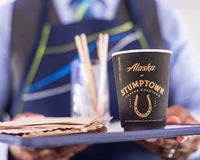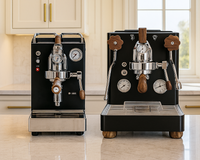Why Is My Espresso Bitter? Common Mistakes and Fixes
Bitter espresso can ruin even the best coffee beans, and it’s one of the most common complaints we hear from home baristas. The good news? You can fix it. With the right adjustments and a bit of practice, your espresso shots can go from harsh and bitter to rich and balanced.
In this guide, we’ll break down the common reasons your espresso tastes bitter, how to troubleshoot each issue, and how to fine-tune your gear and technique to consistently pull great-tasting shots.
1. Over-Extraction: The #1 Culprit
When water spends too much time extracting flavor from your coffee puck, it pulls out unpleasant bitter compounds. This is called over-extraction.
Signs of Over-Extraction:
- Long shot times (30+ seconds)
- Thin crema
- Dry, ashy taste
Fixes:
- Grind coarser: If your grind is too fine, water struggles to pass through, leading to longer extraction times.
- Lower your dose: Too much coffee can slow the flow and over-extract.
- Stop the shot earlier: Try stopping at 25-28 seconds to keep bitter compounds out.

2. Water Temperature Is Too High
High water temperature increases extraction efficiency, but go too hot and you'll extract more bitterness.
Ideal Brew Temp:
195°F to 205°F (90.5°C to 96°C)
Fixes:
- Check your machine settings: If you have a PID controller, reduce the brew temp by 1-2 degrees.
- Flush before brewing: On heat exchangers, flushing helps stabilize brew temps.

3. Your Beans Are Too Dark (or Too Old)
Over-roasted beans naturally lean toward bitter, smoky flavors. Combine that with espresso's intensity and it's a recipe for unpleasant shots.
Fixes:
- Try medium or light roasts: They offer more sweetness and acidity, less bitterness.
- Use fresh beans: Beans stale over time and develop flat, bitter notes. Use within 3–4 weeks of roast date.

4. Channeling: Uneven Extraction
Channeling happens when water finds the path of least resistance through the puck, over-extracting some areas and under-extracting others.
Signs of Channeling:
- Spraying from the portafilter
- Uneven puck after brewing
- Inconsistent taste
Fixes:
- WDT (Weiss Distribution Technique): Stir the grinds with a needle tool before tamping to ensure even distribution.
- Level your tamp: An uneven tamp invites channeling.
- Check your basket fill: Overfilling can cause puck damage during locking in.

5. Your Espresso Machine or Grinder Needs Cleaning
Coffee oils and residues build up fast, especially in grinders, and stale coffee oils taste bitter.
Fixes:
- Clean your grinder: Use grinder cleaning tablets or brush out old grounds weekly.
- Backflush your machine: Especially after switching beans. Use a blind filter and backflush detergent.
- Clean the group head screen: Soak it regularly.

6. Water Quality
Hard or overly mineralized water can contribute to bitterness by interacting with compounds in the coffee.
Fixes:
- Use filtered water: Aim for water with 50–150 ppm total dissolved solids.
- Avoid distilled water: Some machines need minerals for sensors; too pure can cause issues.
Related: Why Your Tap Water Might Be The Secret To Perfect Coffee
7. Roast Profile and Origin Characteristics
Some bitterness is natural. African beans like Robusta or very high-altitude coffees can naturally taste more bitter or sharp. So can some blends designed for milk drinks.
Fixes:
- Know your coffee: Some bitterness is intentional and balanced with sweetness. Look for tasting notes.
- Adjust recipe to the roast: Light roasts often need higher temps and longer shots. Darker roasts usually perform better with shorter extractions and lower temps.
8. You Might Just Prefer a Different Ratio
Espresso isn't one-size-fits-all. The classic 1:2 ratio (e.g., 18g in, 36g out) might not be your ideal.
Fixes:
- Try a shorter shot: A 1:1.5 ratio may be more syrupy and less bitter.
- Experiment with yields: Increase or decrease yield by 2–4g and compare.

9. Grinder Inconsistency
Low-quality or dull burrs can produce uneven particle sizes, leading to uneven extraction and—you guessed it—bitterness.
Fixes:
- Upgrade your grinder: This is often more important than your espresso machine.
- Replace burrs: If your grinder is more than 1–2 years old and heavily used, it might be time.
Related: How To Know When It's Time To Upgrade Your Coffee Gear
10. Let Taste Guide You
Taste is ultimately your best tool. Try side-by-side comparisons:
- Keep everything the same, adjust just one variable
- Take notes after each shot
Final Thoughts: Bitterness Isn’t Always Bad
A touch of bitterness adds structure and complexity to a shot. The goal isn’t zero bitterness—it’s balance. Like a good piece of dark chocolate, a great espresso should have layers.
If your shots are consistently bitter, start with these fixes:
- Check your brew ratio and time
- Lower temperature slightly
- Ensure even puck prep
- Clean your gear
- Try different beans
Dialing in espresso is a journey. But when you get it right, there’s nothing quite like it.
Need help dialing in? Reach out to our team at Cliff & Pebble or explore our collection of grinders and machines. We’re happy to help you pull the best shot of your life.















